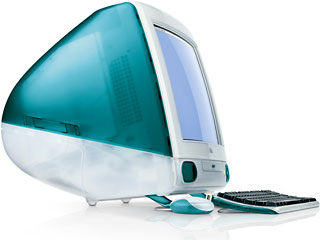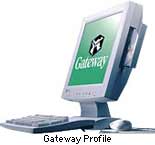1999: It’s been less than a year since the iMac first shipped, but already we’re seeing signs that the “Bondi Bombshell” may have peaked.
 Fortunately for Apple, the iMac peaked early, selling 800,000 units between August 15, 1998 and the end of the calendar year. Sales continued at a brisk pace, keeping the iMac in the #1 sales position until April.
Fortunately for Apple, the iMac peaked early, selling 800,000 units between August 15, 1998 and the end of the calendar year. Sales continued at a brisk pace, keeping the iMac in the #1 sales position until April.
Then all models broke loose. You could buy the Bondi second edition iMac, the tutti-frutti 266 MHz model in one of five colors, or the brand-new-and-barely-available 333 MHz iMac.
All told, eleven iMac SKUs were available in April, and not a single one of them made the Top Five list. The best seller was the Bondi model, reaching #7 in sales. The more expensive 266 MHz and 333 MHz models trailed all the way down the list.
All told, the sum total of iMacs sold would have made it #1 in April. Some sites (including Mac Sales Up, iMac Sales Down? here) made note of that. But the reality is, there were three different iMacs available in April. One came in Bondi; two came in your choice of five colors but at different speeds.
PC Data should have ignored colors and reported sales for the 233, 266, and 333 MHz iMacs as separate models.
Regardless, even that way of counting probably would not have kept any single version of iMac in the Top Five.
Oddly enough, the Bondi original was the most popular model – and will probably remain so while inventory lasts. After all, it’s significantly less expensive than the more colorful newer models.

But the PC industry is starting to move toward Apple’s integrated design. The Gateway Profile is a first step in that direction, although it bears somewhat more resemblance to the Twentieth Anniversary Macintosh than to the iMac.
Still, integration is a wave of the future. The iMac has been so successful that we now take it for granted. As cool as the iMac was in August and even December, it has set the trend and needs to be replaced by a new trendsetter for the consumer market.
Rumors are that a new iMac with a 17″ screen may appear this summer. Possible additions include FireWire for fast external drives and a DVD drive for games and movies. Odds are it will share a lot of components with the PowerBook G3 and Blue and White Power Mac G3, not only to keep costs down but to give it even better performance than the current iMac.
One site has shown a possible iMac II that looks like Apple’s 17″ Studio Display with a CD-ROM or DVD drive below the screen. The feet would make it easy to push the keyboard out of the way when it’s not in use.
In a year, the iMac has gone from radical to expectedly cool. Before it becomes passé, let’s hope Apple unveils a worthy successor to lead its consumer computer line into the next century.
keywords: #imac #gatewayprofile

